Abstract
1. Human detection thresholds for a vibratory stimulus applied to the volar surface of the index finger were examined under conditions where afferents from specific tactile receptor classes were simultaneously activated from the thenar eminence. The experiments were designed to test whether stimuli which have been shown previously to induce afferent inhibition of `tactile' neurones in the cuneate nucleus of the cat could modify human subjective performance in a tactile detection task. Conditioning stimuli to the thenar eminence were usually of three forms; steady indentation to engage slowly adapting tactile receptors; 300 Hz vibration to engage Pacinian corpuscles; and 30 Hz vibration to engage the intradermal, rapidly adapting tactile receptors which are thought to be Meissner's corpuscles.
2. In ten subjects the mean detection threshold for a 30 Hz test stimulus in the absence of conditioning stimulation was 8·6 ± 1·0 μm (S.E.). Detection thresholds were increased substantially in the presence of a 300 Hz, 100 μm conditioning stimulus (mean increase 11·1 ± 2·0 μm), whereas minor or insignificant effects were seen with conditioning stimuli consisting of (a) 30 Hz, 100 μm (mean increase 1·4 ± 0·8 μm), (b) steady indentation, 1·5 mm in amplitude (mean increase 1·3 ± 0·7 μm) or (c) 300 Hz, 100 μm to the contralateral thenar eminence (mean increase 0·4 ± 0·5 μm).
3. The 300 Hz conditioning stimulus to the ipsilateral thenar eminence caused a marked increase in detection thresholds at all test stimulus frequencies over the range 10-450 Hz. The effects of the conditioning stimulation therefore operated on inputs from Pacinian corpuscles, which are responsible for vibration detection at 80-450 Hz, and on inputs from the intradermal, rapidly adapting receptors which are responsible for vibration detection at 10-80 Hz.
4. The band width of conditioning vibratory frequencies which was effective at amplitudes of 100 μm in bringing about increases in detection threshold extended from 50-80 Hz to 300 Hz, the maximum tested.
5. Whereas amplitudes of 1-2 μm produced clear increases in detection thresholds with conditioning stimuli of 300 Hz, amplitudes of > 200 μm were needed at 30 Hz.
6. The observed elevations in detection threshold are consistent with an afferent-induced inhibitory action exerted at synaptic relays of the sensory pathway by tactile inputs arising exclusively or predominantly from Pacinian corpuscles.
Full text
PDF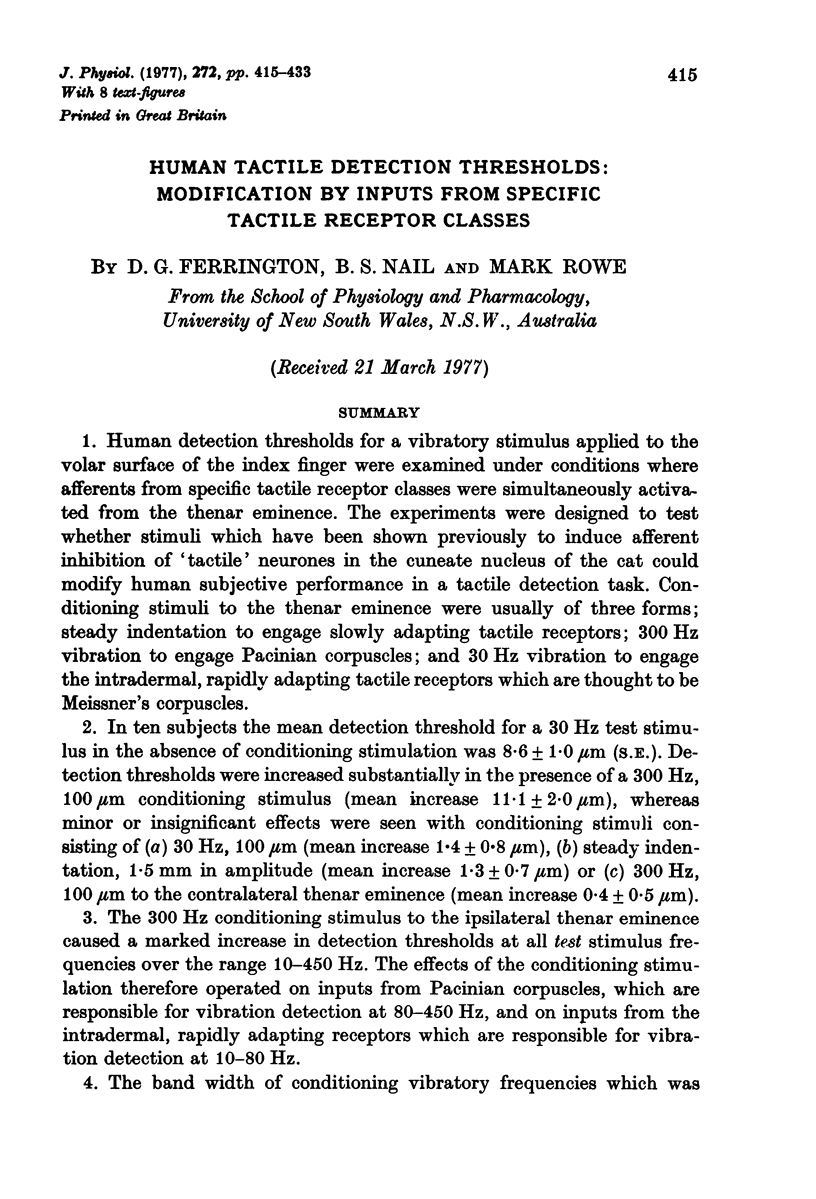
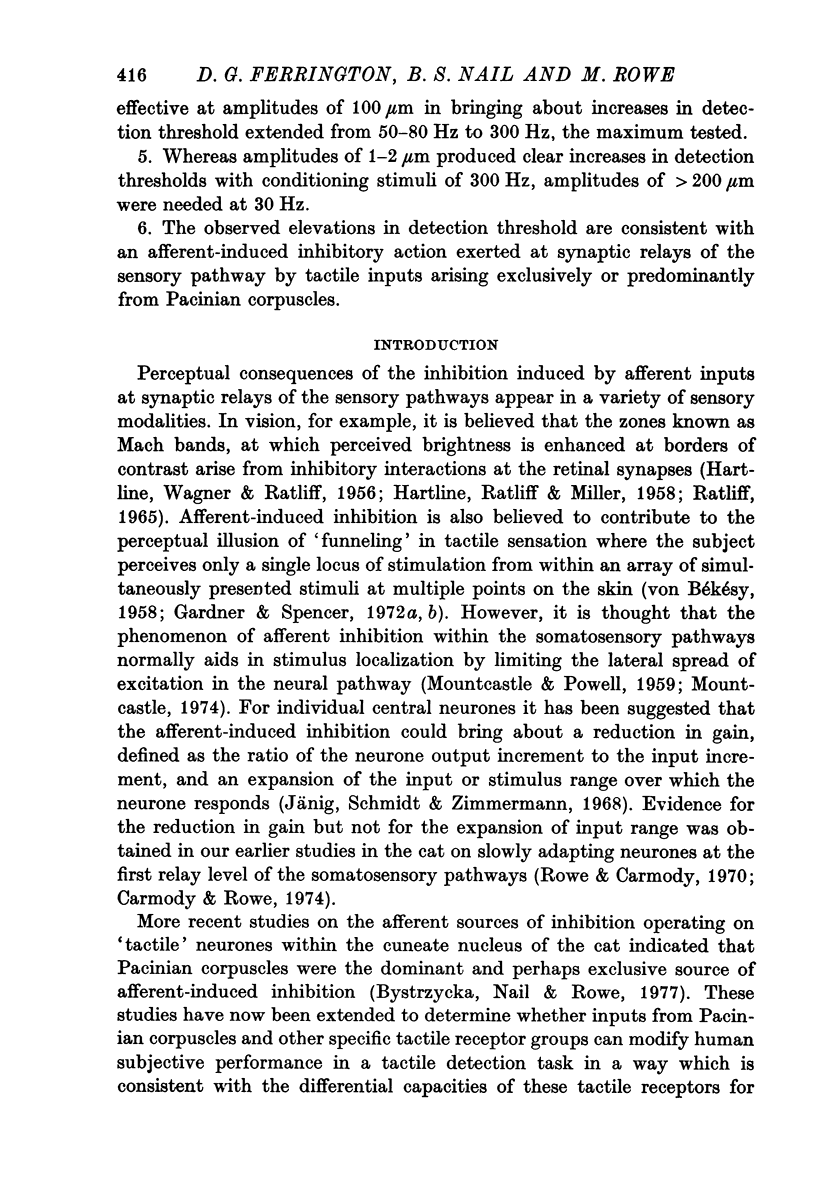
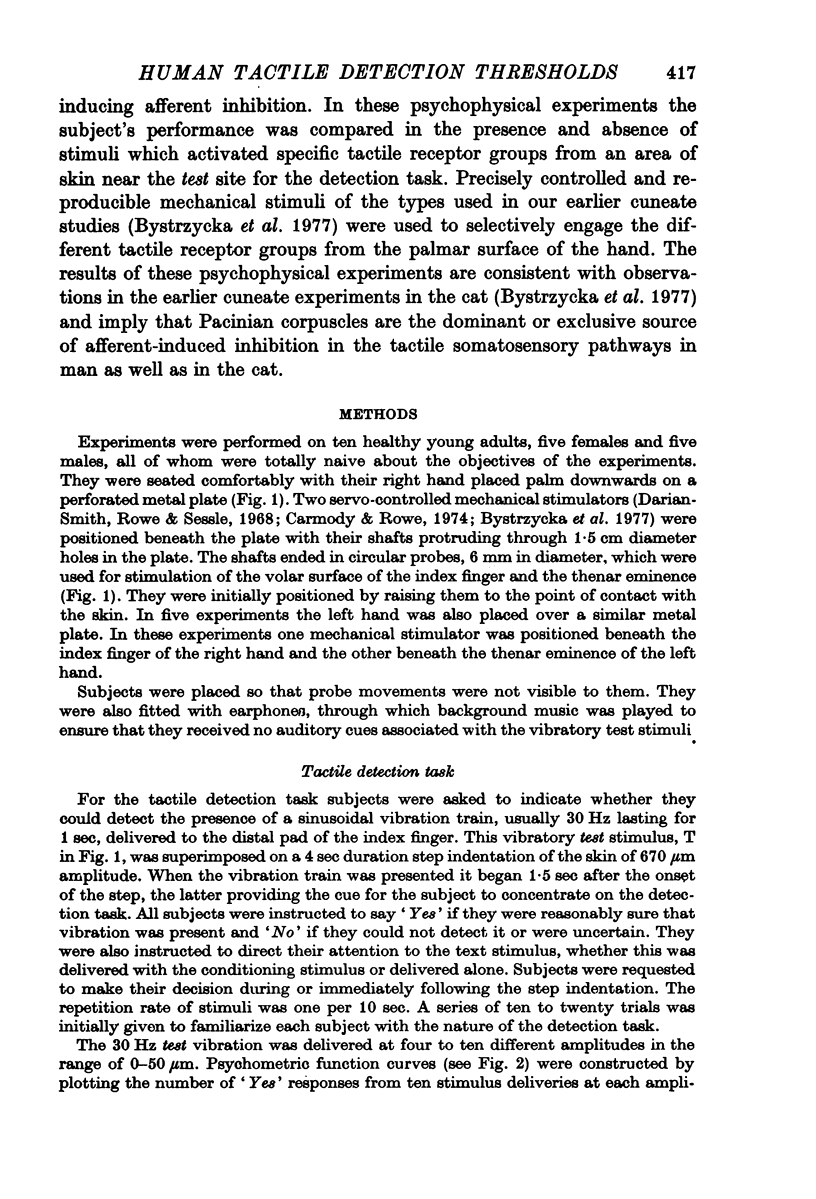
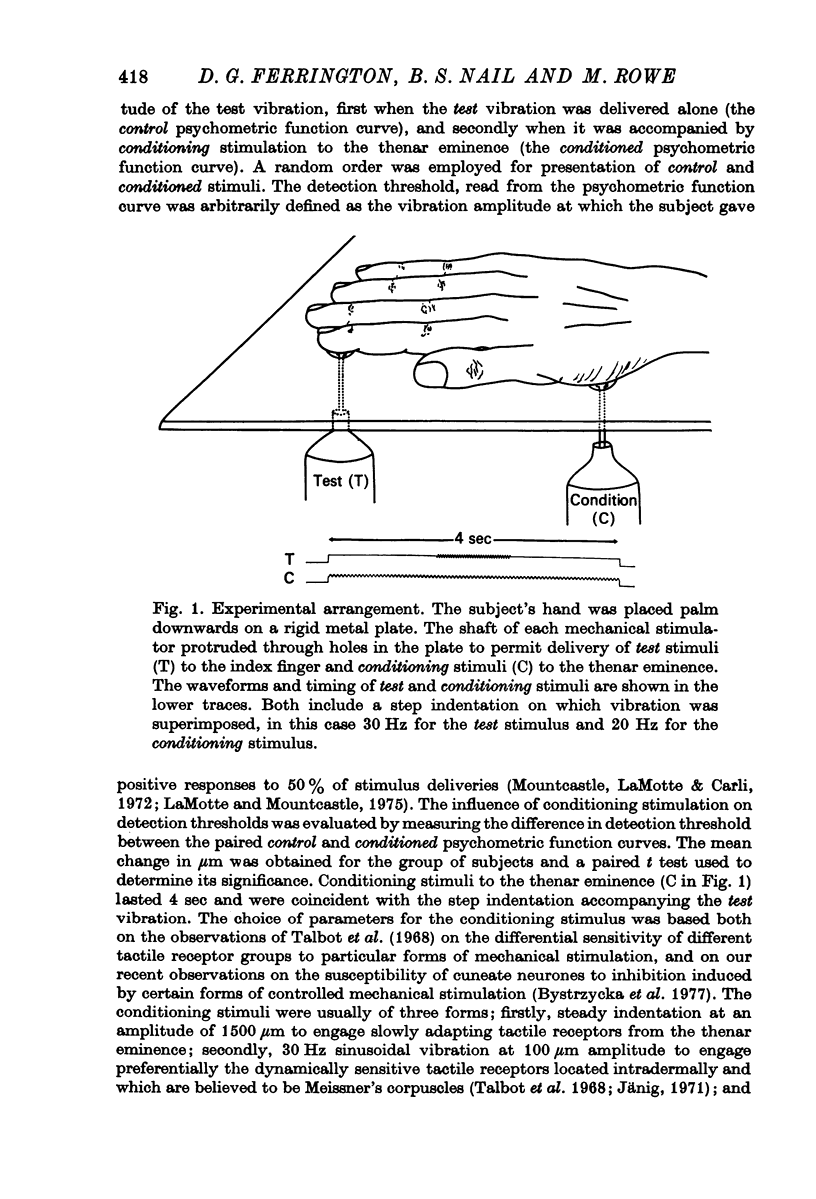
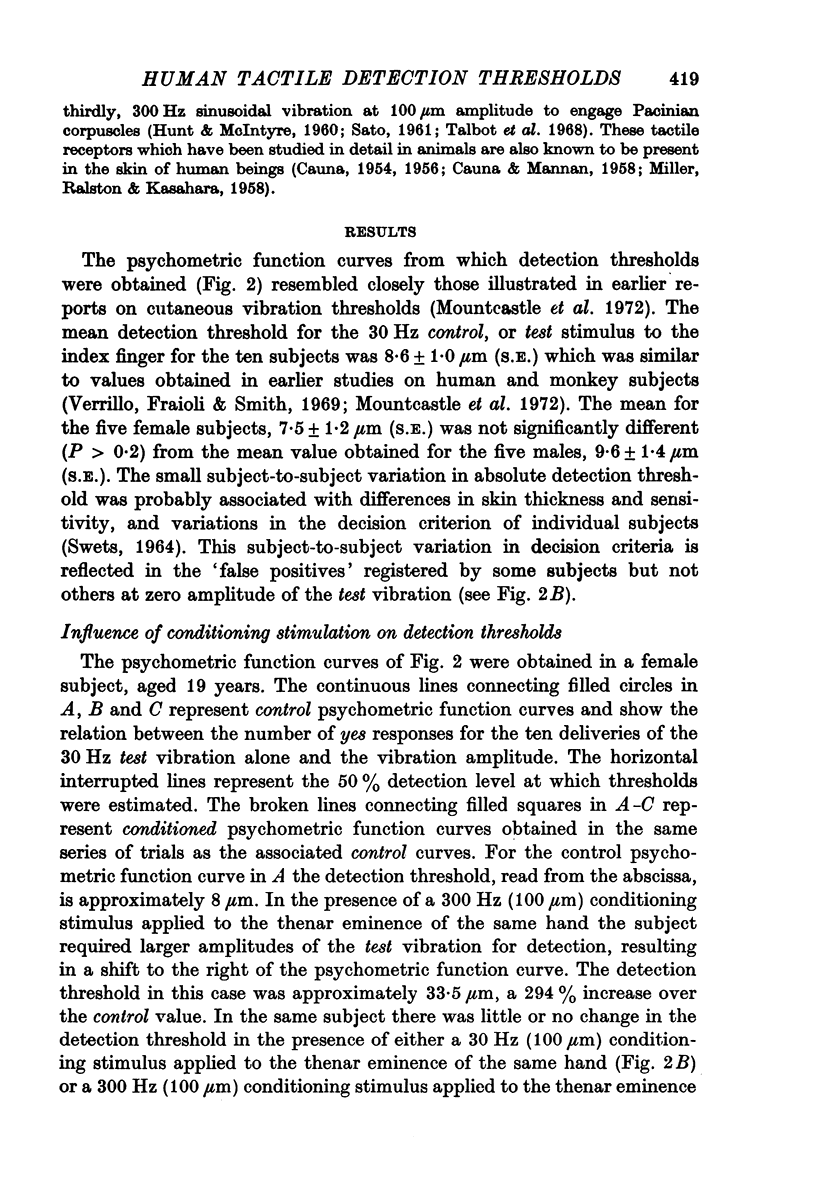
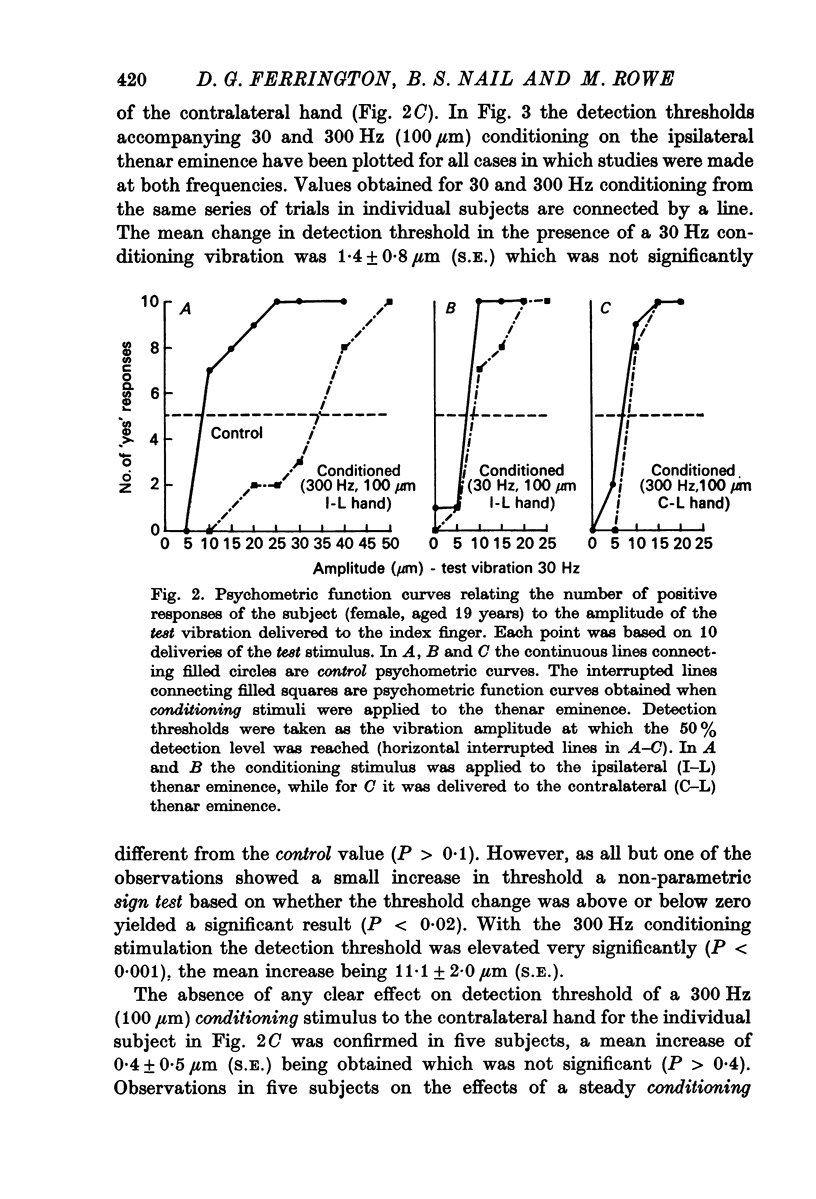
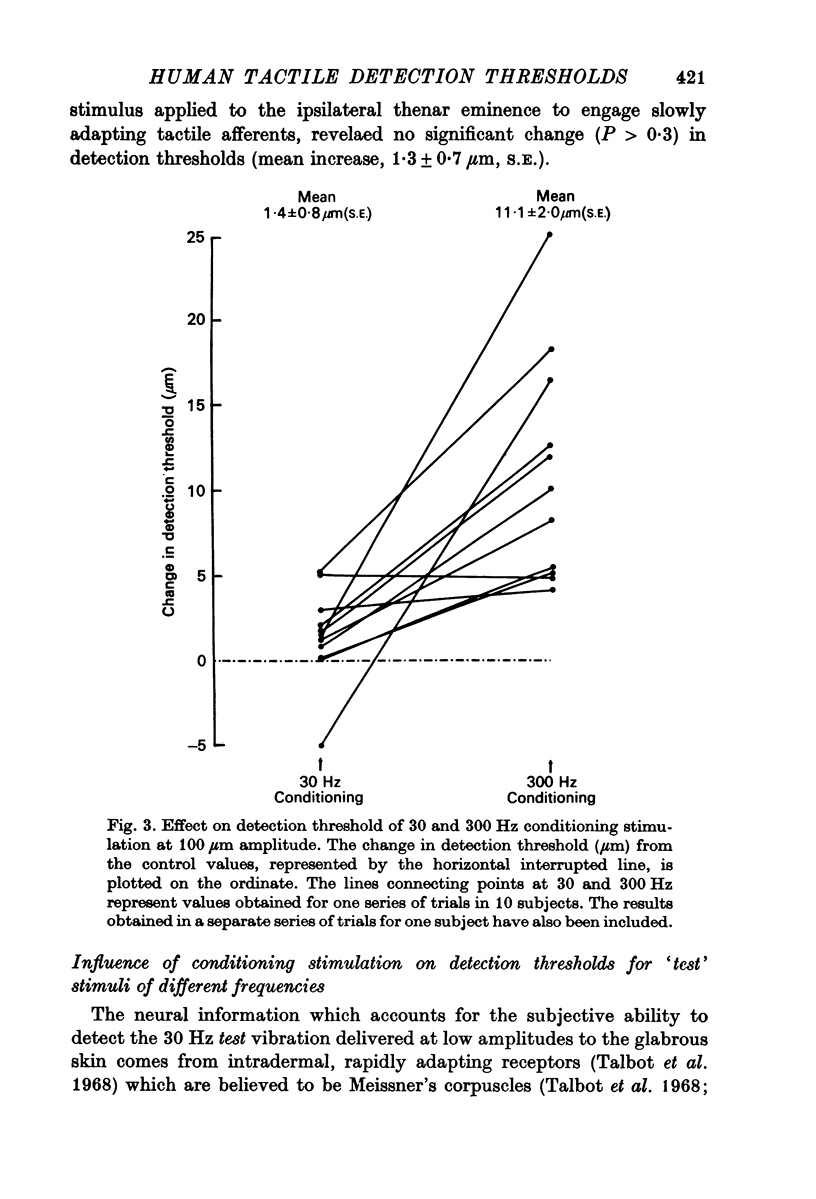
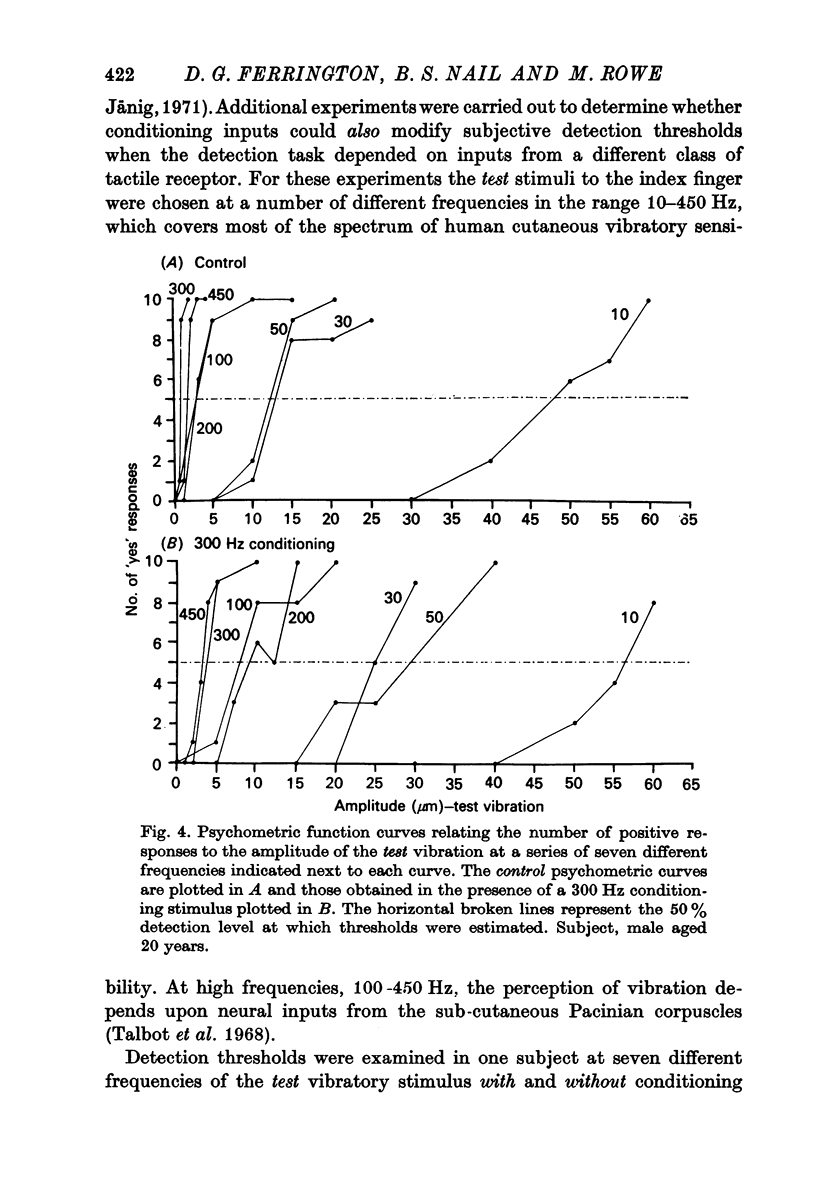
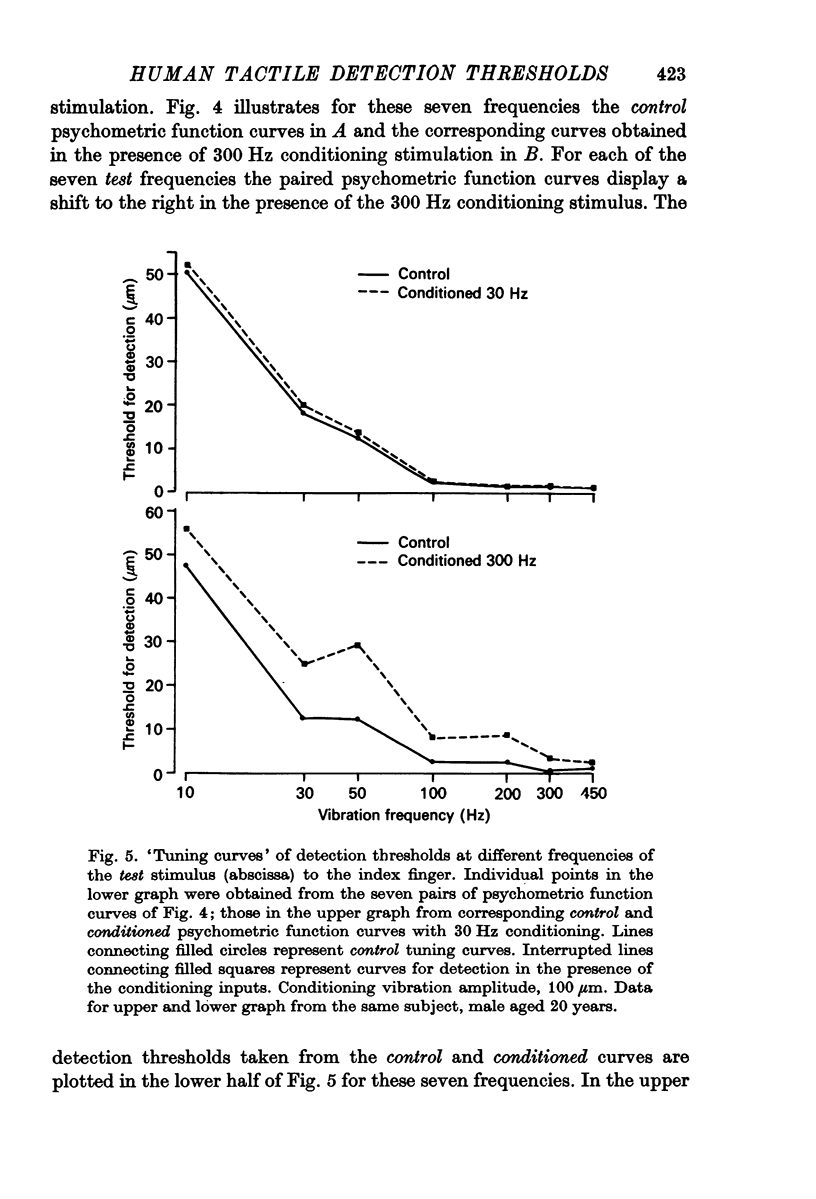
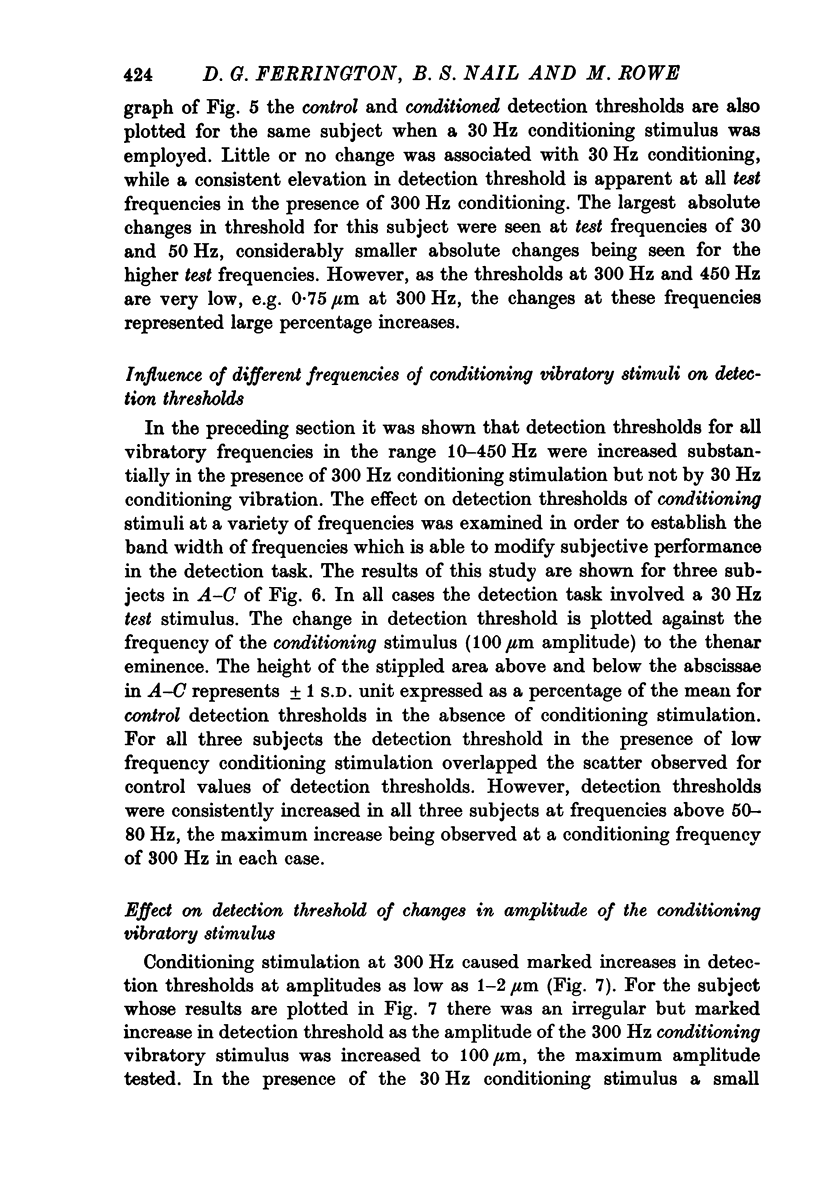
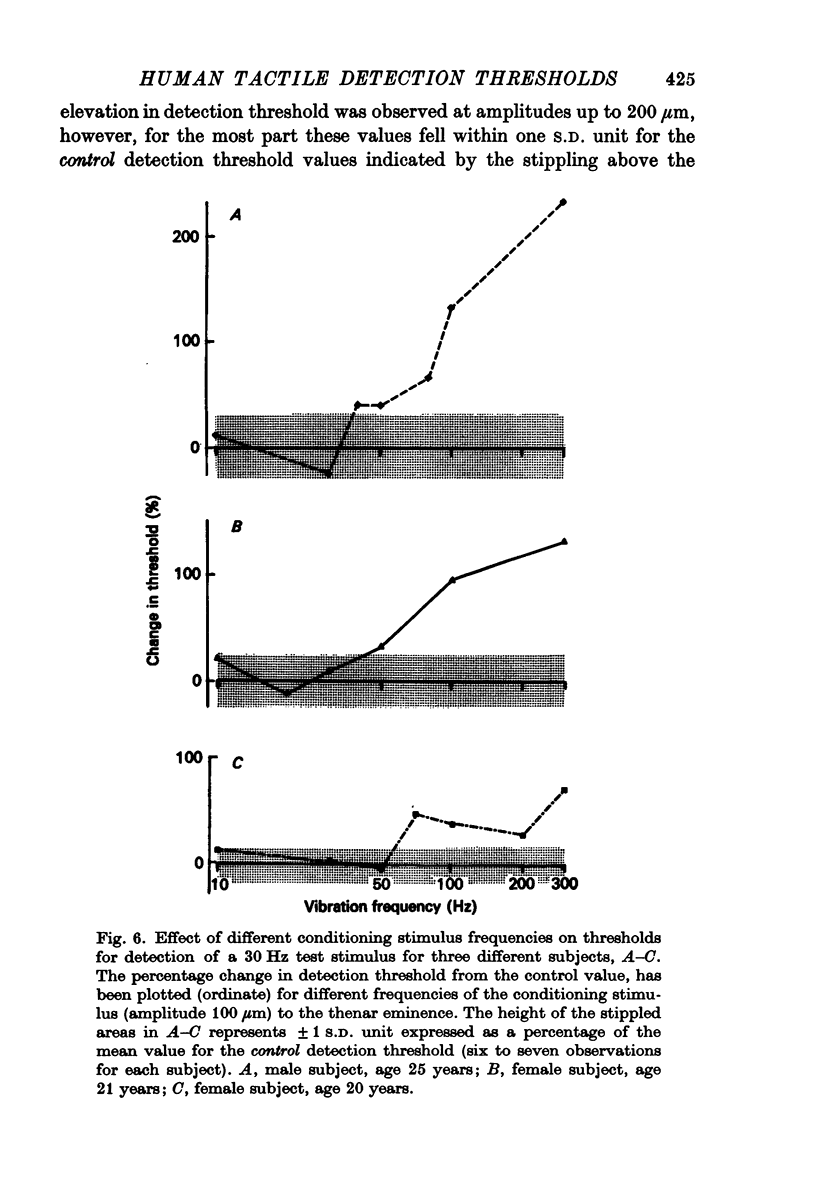
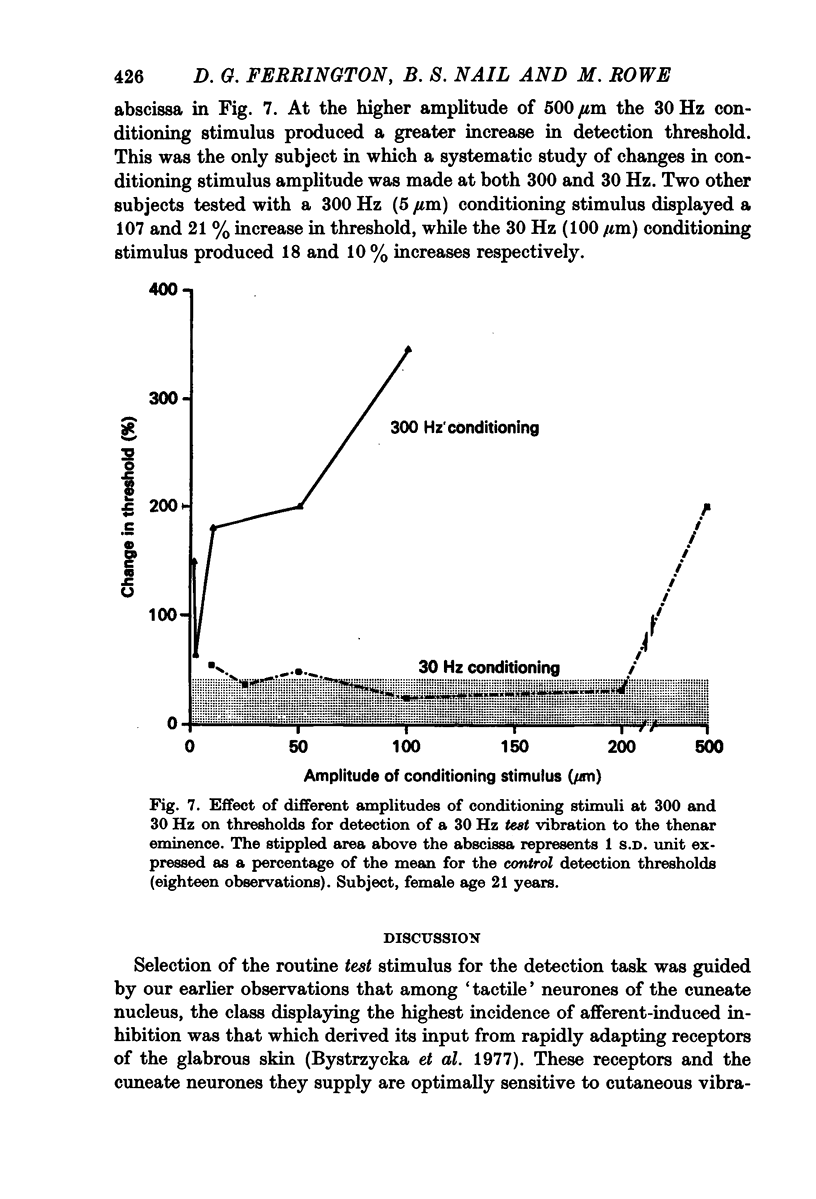
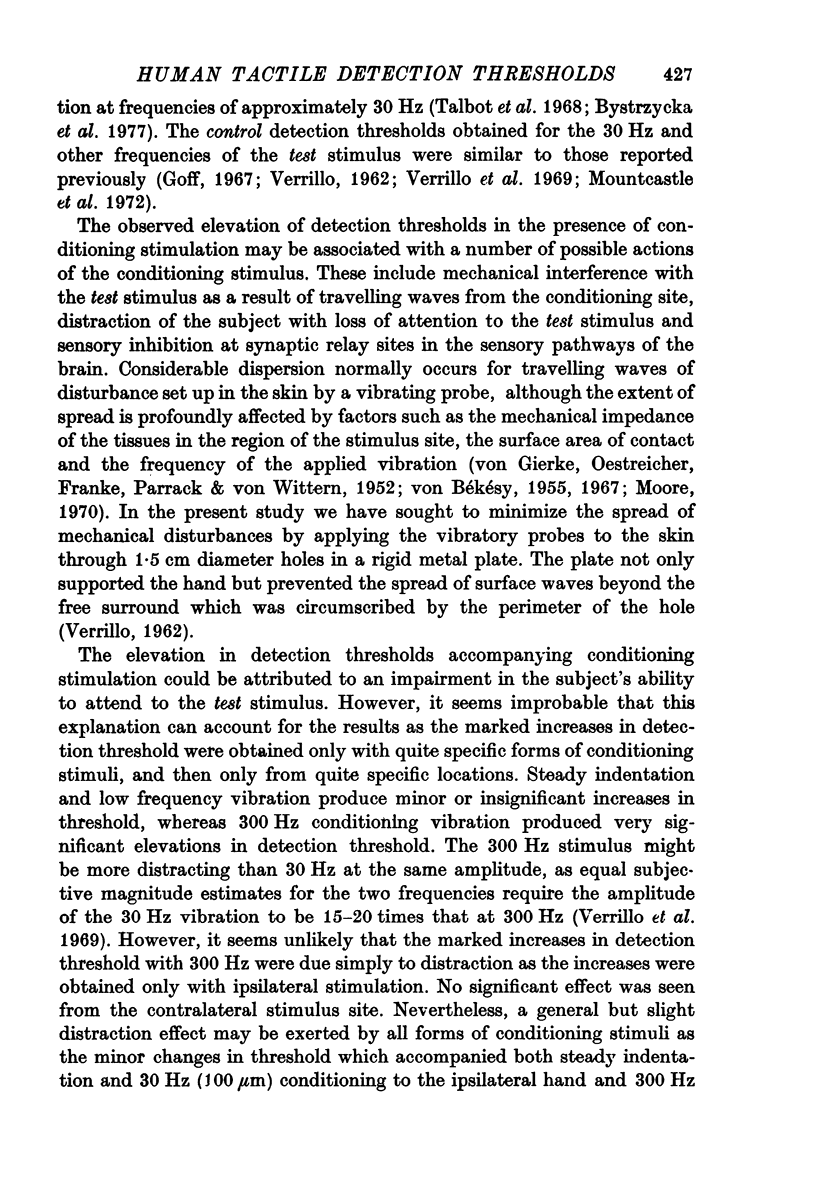
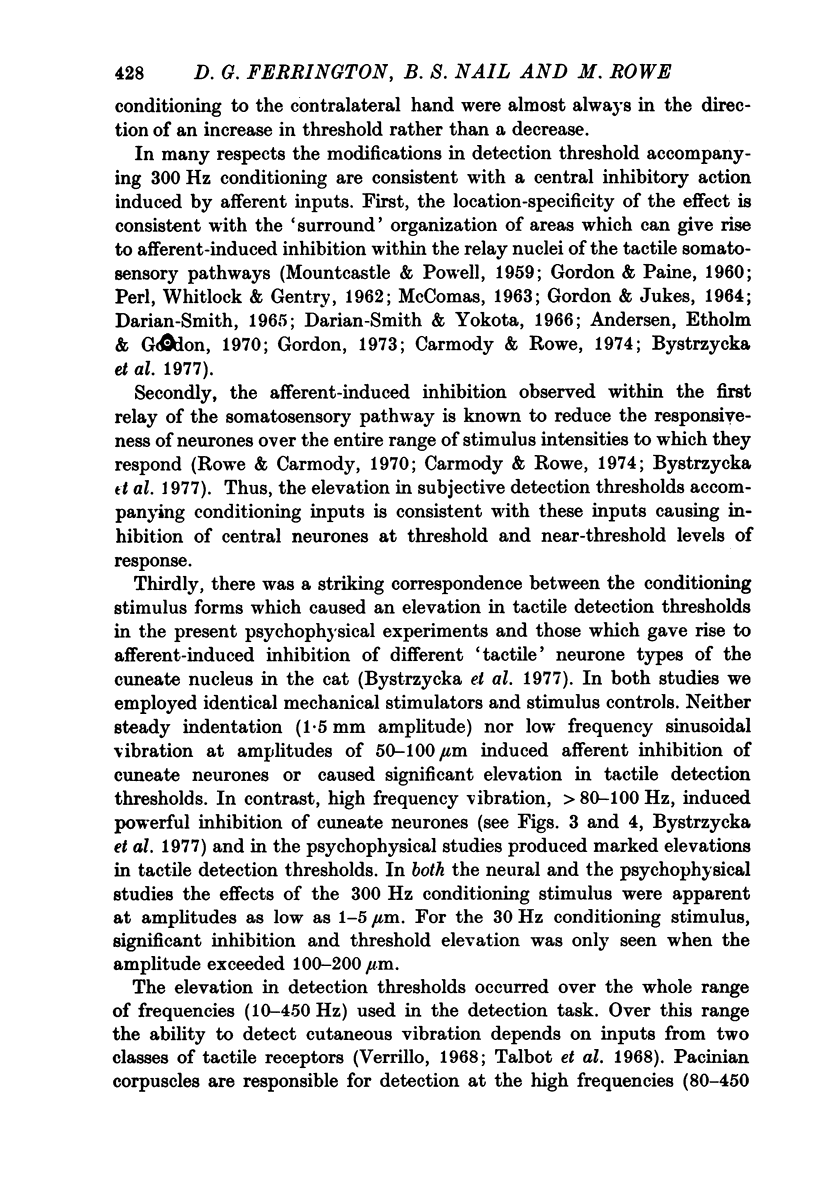
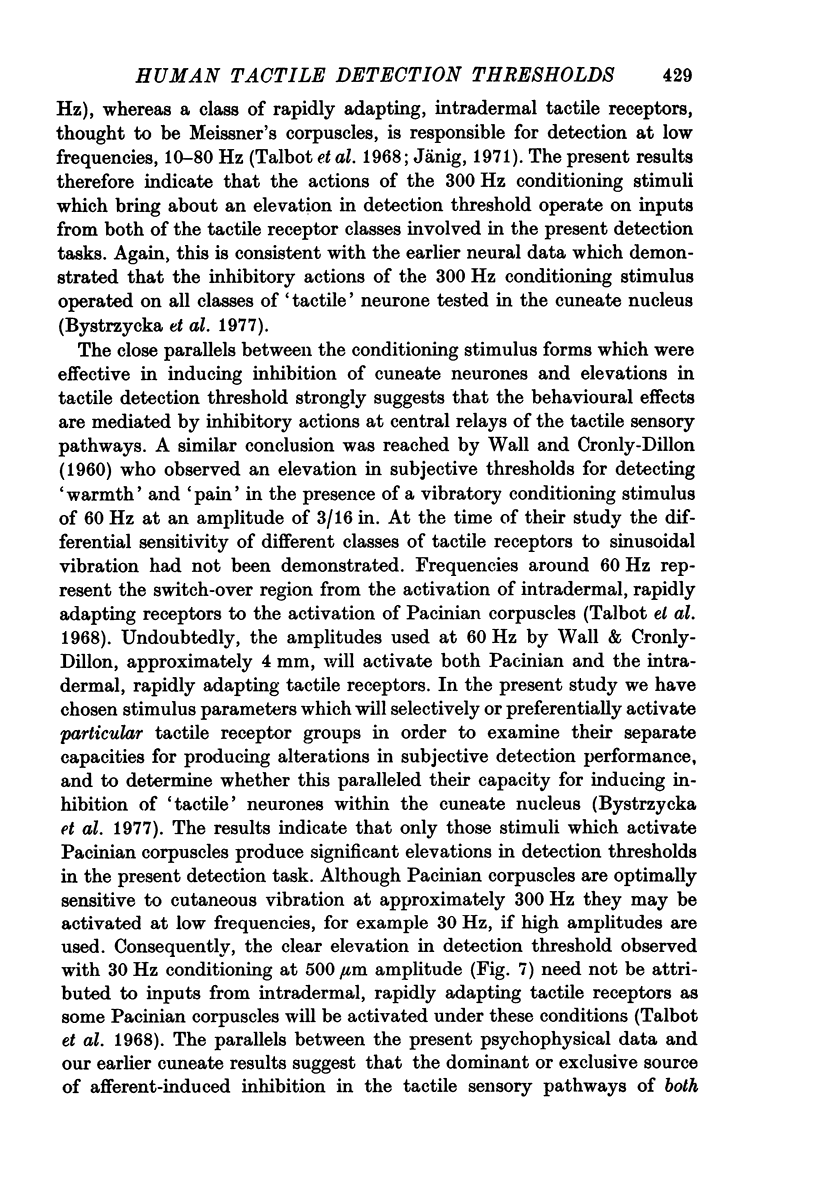
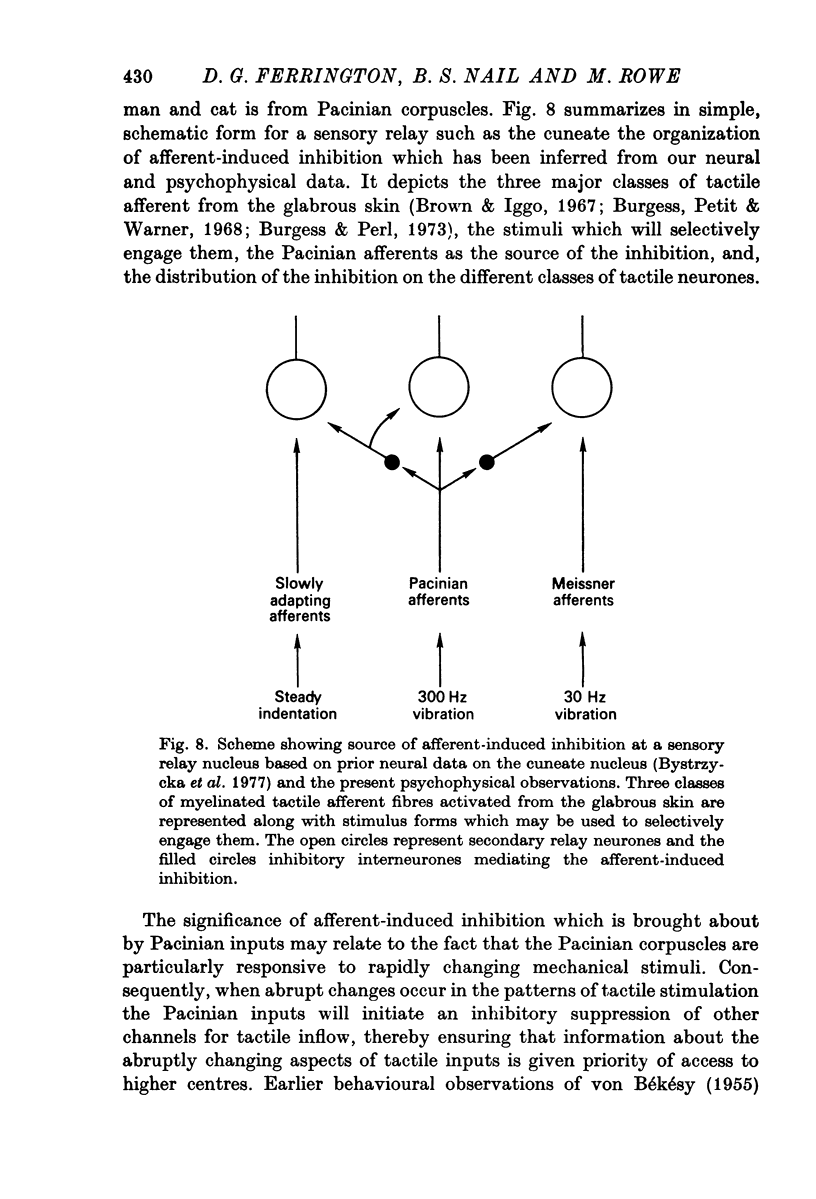
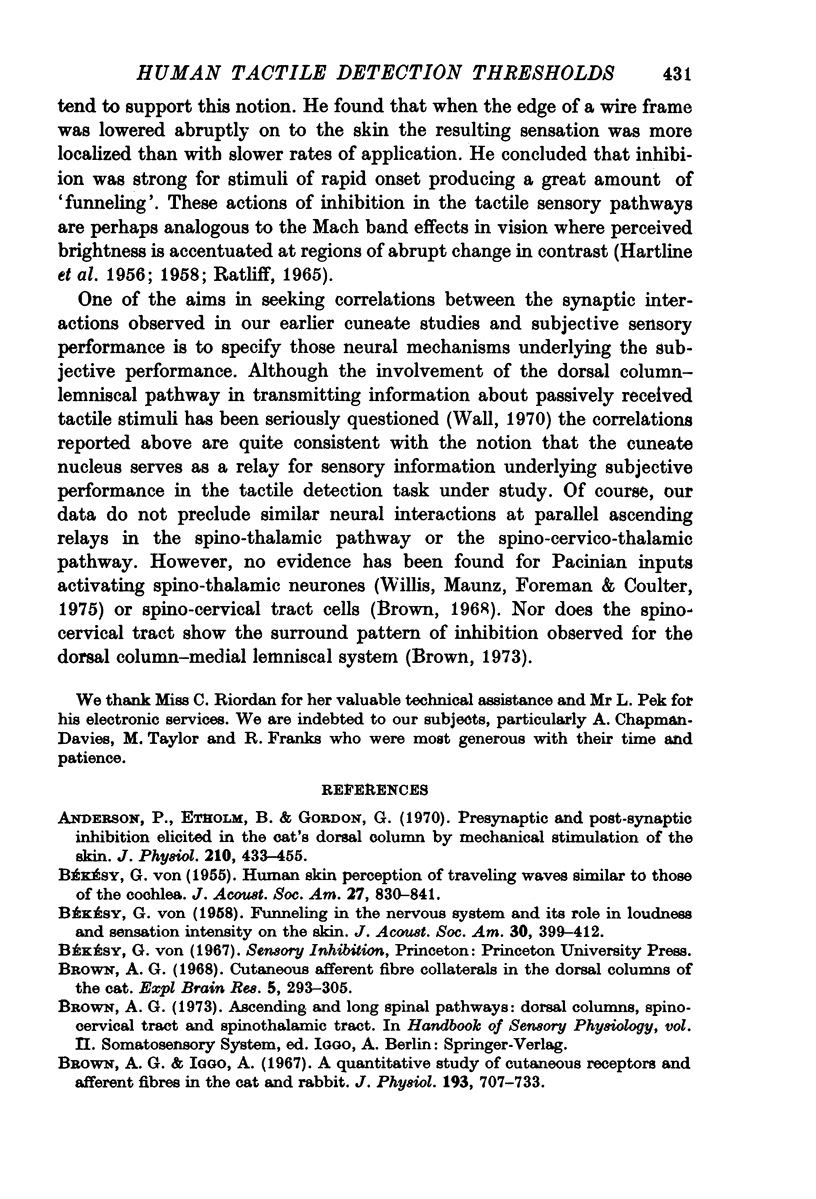
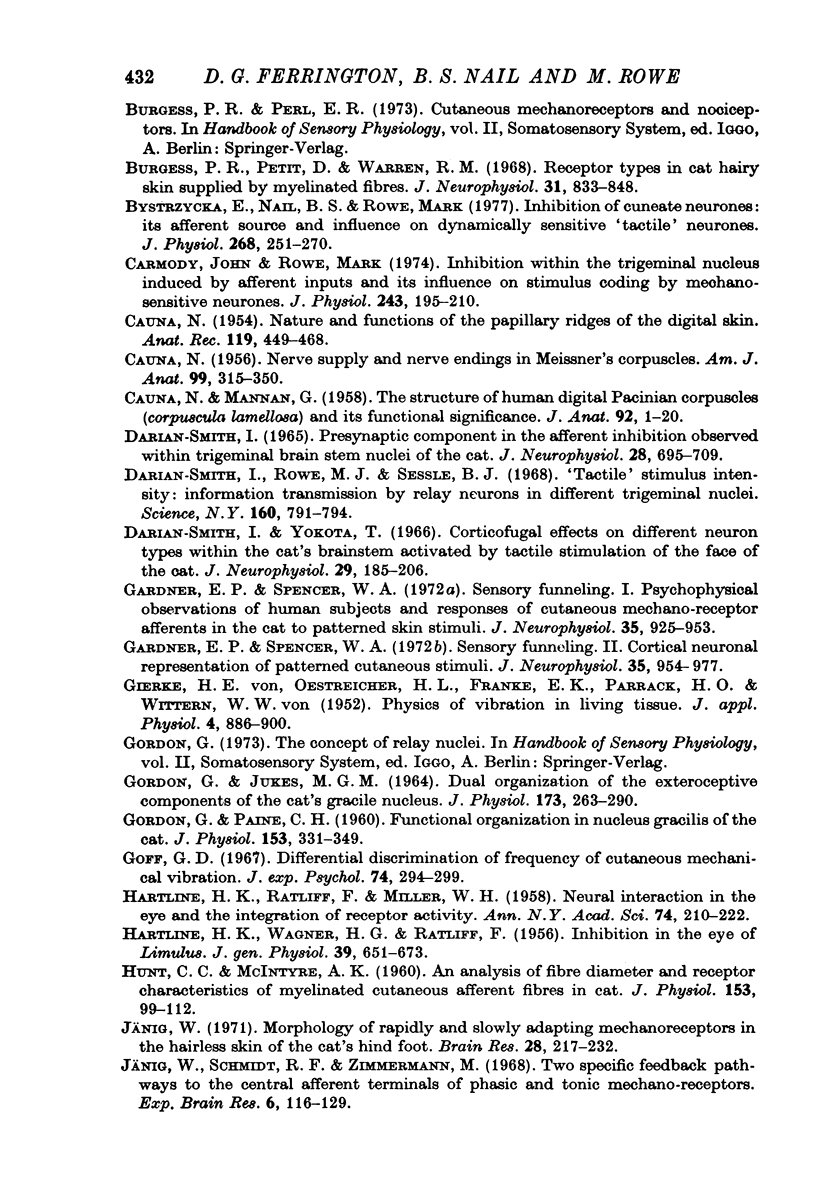
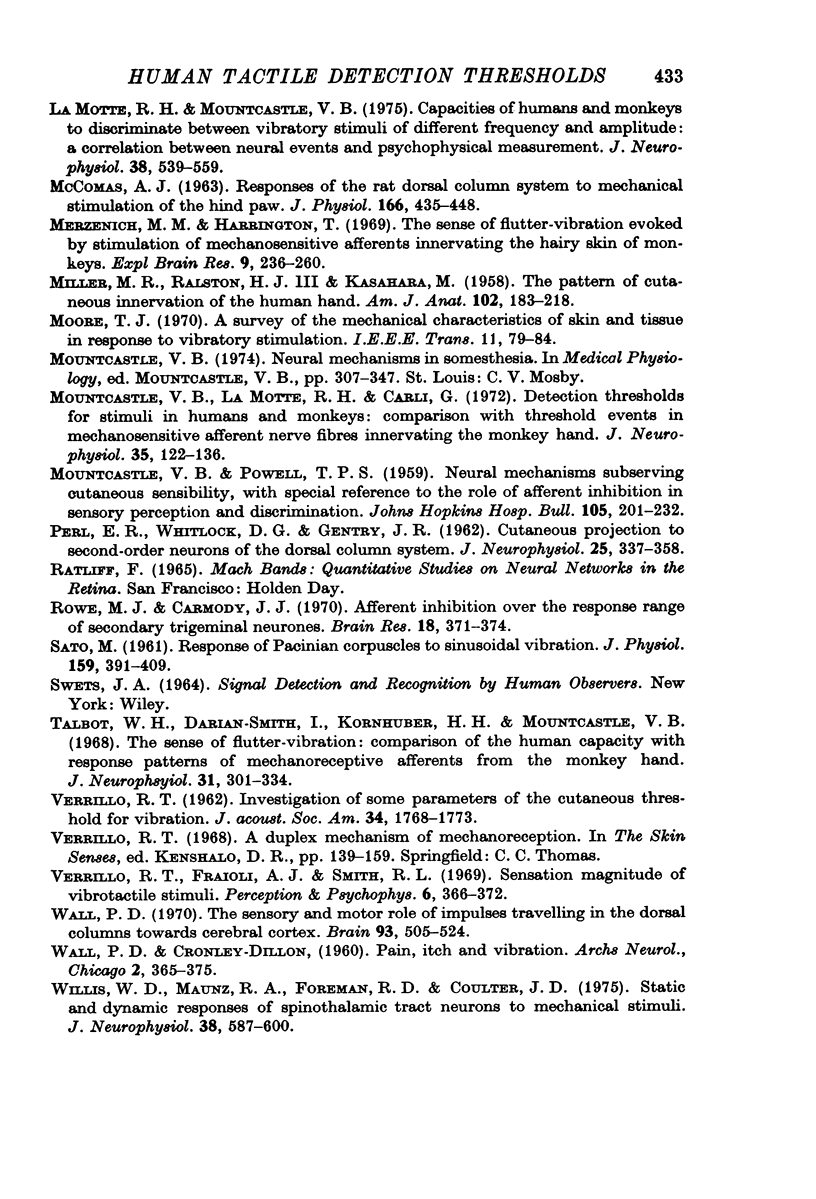
Selected References
These references are in PubMed. This may not be the complete list of references from this article.
- Andersen P., Etholm B., Gordon G. Presynaptic and post-synaptic inhibition elicited in the cat's dorsal column nuclei by mechanical stimulation of skin. J Physiol. 1970 Sep;210(2):433–455. doi: 10.1113/jphysiol.1970.sp009219. [DOI] [PMC free article] [PubMed] [Google Scholar]
- Brown A. G. Cutaneous afferent fibre collaterals in the dorsal columns of the cat. Exp Brain Res. 1968;5(4):293–305. doi: 10.1007/BF00235904. [DOI] [PubMed] [Google Scholar]
- Brown A. G., Iggo A. A quantitative study of cutaneous receptors and afferent fibres in the cat and rabbit. J Physiol. 1967 Dec;193(3):707–733. doi: 10.1113/jphysiol.1967.sp008390. [DOI] [PMC free article] [PubMed] [Google Scholar]
- Burgess P. R., Petit D., Warren R. M. Receptor types in cat hairy skin supplied by myelinated fibers. J Neurophysiol. 1968 Nov;31(6):833–848. doi: 10.1152/jn.1968.31.6.833. [DOI] [PubMed] [Google Scholar]
- Bystrzycka E., NAil B. S., Rowe M. Inhibition of cuneate neurones: its afferent source and influence on dynamically sensitive "tactile" neurones. J Physiol. 1977 Jun;268(1):251–270. doi: 10.1113/jphysiol.1977.sp011856. [DOI] [PMC free article] [PubMed] [Google Scholar]
- CAUNA N., MANNAN G. The structure of human digital pacinian corpuscles (corpus cula lamellosa) and its functional significance. J Anat. 1958 Jan;92(1):1–20. [PMC free article] [PubMed] [Google Scholar]
- CAUNA N. Nature and functions of the papillary ridges of the digital skin. Anat Rec. 1954 Aug;119(4):449–468. doi: 10.1002/ar.1091190405. [DOI] [PubMed] [Google Scholar]
- CAUNA N. Nerve supply and nerve endings in Meissner's corpuscles. Am J Anat. 1956 Sep;99(2):315–350. doi: 10.1002/aja.1000990206. [DOI] [PubMed] [Google Scholar]
- Carmody J., Rowe M. Inhibition within the trigeminal nucleus induced by afferent inputs and its influence on stimulus coding by mechanosensitive neurones. J Physiol. 1974 Nov;243(1):195–210. doi: 10.1113/jphysiol.1974.sp010749. [DOI] [PMC free article] [PubMed] [Google Scholar]
- DARIAN-SMITH I. PRESYNAPTIC COMPONENT IN THE AFFERENT INHIBITION OBSERVED WITHIN TRIGEMINAL BRAIN-STEM NUCLEI OF THE CAT. J Neurophysiol. 1965 Jul;28:695–709. doi: 10.1152/jn.1965.28.4.695. [DOI] [PubMed] [Google Scholar]
- Darian-Smith I., Rowe M. J., Sessle B. J. "Tactile" stimulus intensity: information transmission by relay neurons in different trigeminal nuclei. Science. 1968 May 17;160(3829):791–794. doi: 10.1126/science.160.3829.791. [DOI] [PubMed] [Google Scholar]
- Darian-Smith I., Yokota T. Corticofugal effects on different neuron types within the cat's brain stem activated by tactile stimulation of the face. J Neurophysiol. 1966 Mar;29(2):185–206. doi: 10.1152/jn.1966.29.2.185. [DOI] [PubMed] [Google Scholar]
- GIERKE H. E. V., OESTREICHER H. L., FRANKE E. K., PARRACK H. O., WITTERN W. W. V. Physics of vibrations in living tissues. J Appl Physiol. 1952 Jun;4(12):886–900. doi: 10.1152/jappl.1952.4.12.886. [DOI] [PubMed] [Google Scholar]
- GORDON G., JUKES M. G. DUAL ORGANIZATION OF THE EXTEROCEPTIVE COMPONENTS OF THE CAT'S GRACILE NUCLEUS. J Physiol. 1964 Sep;173:263–290. doi: 10.1113/jphysiol.1964.sp007456. [DOI] [PMC free article] [PubMed] [Google Scholar]
- GORDON G., PAINE C. H. Functional organization in nucleus gracilis of the cat. J Physiol. 1960 Sep;153:331–349. doi: 10.1113/jphysiol.1960.sp006537. [DOI] [PMC free article] [PubMed] [Google Scholar]
- Gardner E. P., Spencer W. A. Sensory funneling. I. Psychophysical observations of human subjects and responses of cutaneous mechanoreceptive afferents in the cat to patterned skin stimuli. J Neurophysiol. 1972 Nov;35(6):925–953. doi: 10.1152/jn.1972.35.6.925. [DOI] [PubMed] [Google Scholar]
- Gardner E. P., Spencer W. A. Sensory funneling. II. Cortical neuronal representation of patterned cutaneous stimuli. J Neurophysiol. 1972 Nov;35(6):954–977. doi: 10.1152/jn.1972.35.6.954. [DOI] [PubMed] [Google Scholar]
- Goff G. D. Differential discrimination of frequency of cutaneous mechanical vibration. J Exp Psychol. 1967 Jun;74(2):294–299. doi: 10.1037/h0024561. [DOI] [PubMed] [Google Scholar]
- HARTLINE H. K., WAGNER H. G., RATLIFF F. Inhibition in the eye of Limulus. J Gen Physiol. 1956 May 20;39(5):651–673. doi: 10.1085/jgp.39.5.651. [DOI] [PMC free article] [PubMed] [Google Scholar]
- HUNT C. C., McINTYRE A. K. An analysis of fibre diameter and receptor characteristics of myelinated cutaneous afferent fibres in cat. J Physiol. 1960 Aug;153:99–112. doi: 10.1113/jphysiol.1960.sp006521. [DOI] [PMC free article] [PubMed] [Google Scholar]
- Jänig W. Morphology of rapidly and slowly adapting mechanoreceptors in the hairless skin of the cat's hind foot. Brain Res. 1971 May 7;28(2):217–231. doi: 10.1016/0006-8993(71)90656-1. [DOI] [PubMed] [Google Scholar]
- Jänig W., Schmidt R. F., Zimmermann M. Two specific feedback pathways to the central afferent terminals of phasic and tonic mechanoreceptors. Exp Brain Res. 1968;6(2):116–129. doi: 10.1007/BF00239166. [DOI] [PubMed] [Google Scholar]
- LaMotte R. H., Mountcastle V. B. Capacities of humans and monkeys to discriminate vibratory stimuli of different frequency and amplitude: a correlation between neural events and psychological measurements. J Neurophysiol. 1975 May;38(3):539–559. doi: 10.1152/jn.1975.38.3.539. [DOI] [PubMed] [Google Scholar]
- MILLER M. R., RALSTON H. J., 3rd, KASAHARA M. The pattern of cutaneous innervation of the human hand. Am J Anat. 1958 Mar;102(2):183–217. doi: 10.1002/aja.1001020203. [DOI] [PubMed] [Google Scholar]
- MOUNTCASTLE V. B., POWELL T. P. Neural mechanisms subserving cutaneous sensibility, with special reference to the role of afferent inhibition in sensory perception and discrimination. Bull Johns Hopkins Hosp. 1959 Oct;105:201–232. [PubMed] [Google Scholar]
- Merzenich M. M., Harrington T. H. The sense of flutter-vibration evoked by stimulation of the hairy skin of primates: comparison of human sensory capacity with the responses of mechanoreceptive afferents innervating the hairy skin of monkeys. Exp Brain Res. 1969;9(3):236–260. doi: 10.1007/BF00234457. [DOI] [PubMed] [Google Scholar]
- Mountcastle V. B., LaMotte R. H., Carli G. Detection thresholds for stimuli in humans and monkeys: comparison with threshold events in mechanoreceptive afferent nerve fibers innervating the monkey hand. J Neurophysiol. 1972 Jan;35(1):122–136. doi: 10.1152/jn.1972.35.1.122. [DOI] [PubMed] [Google Scholar]
- PERL E. R., WHITLOCK D. G., GENTRY J. R. Cutaneous projection to second-order neurons of the dorsal column system. J Neurophysiol. 1962 May;25:337–358. doi: 10.1152/jn.1962.25.3.337. [DOI] [PubMed] [Google Scholar]
- RATLIFF F., MILLER W. H., HARTLINE H. K. Neural interaction in the eye and the integration of receptor activity. Ann N Y Acad Sci. 1959 Nov 12;74(2):210–222. doi: 10.1111/j.1749-6632.1958.tb39546.x. [DOI] [PubMed] [Google Scholar]
- Rowe M. J., Carmody J. J. Afferent inhibition over the response range of secondary trigeminal neurones. Brain Res. 1970 Mar 3;18(2):371–374. doi: 10.1016/0006-8993(70)90338-0. [DOI] [PubMed] [Google Scholar]
- SATO M. Response of Pacinian corpuscles to sinusoidal vibration. J Physiol. 1961 Dec;159:391–409. doi: 10.1113/jphysiol.1961.sp006817. [DOI] [PMC free article] [PubMed] [Google Scholar]
- Talbot W. H., Darian-Smith I., Kornhuber H. H., Mountcastle V. B. The sense of flutter-vibration: comparison of the human capacity with response patterns of mechanoreceptive afferents from the monkey hand. J Neurophysiol. 1968 Mar;31(2):301–334. doi: 10.1152/jn.1968.31.2.301. [DOI] [PubMed] [Google Scholar]
- WALL P. D., CRONLY-DILLON J. R. Pain, itch, and vibration. Arch Neurol. 1960 Apr;2:365–375. doi: 10.1001/archneur.1960.03840100003002. [DOI] [PubMed] [Google Scholar]
- Wall P. D. The sensory and motor role of impulses travelling in the dorsal columns towards cerebral cortex. Brain. 1970;93(3):505–524. doi: 10.1093/brain/93.3.505. [DOI] [PubMed] [Google Scholar]
- Willis W. D., Maunz R. A., Foreman R. D., Coulter J. D. Static and dynamic responses of spinothalamic tract neurons to mechanical stimuli. J Neurophysiol. 1975 May;38(3):587–600. doi: 10.1152/jn.1975.38.3.587. [DOI] [PubMed] [Google Scholar]


